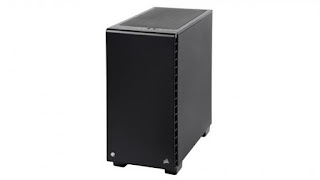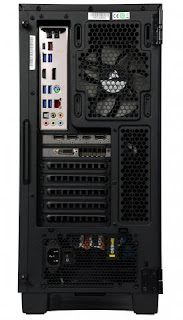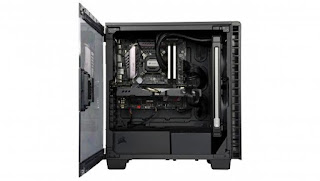Appropriately for a system with both
'Box' and 'Cube' in its name, this premium gaming PC is pleasantly small,
square and squat. It’s still got a conventional form factor and internal
layout, but is definitely at the smaller end of the mid-tower spectrum, giving
it a far more unassuming look than most £1,000+ gaming rigs while improving
portability to boot.
It’s far from cramped on the inside,
though; in fact, it’s beautifully tidy, with plenty of room for airflow. It
also benefits from a hinge-mounted, transparent side door that’s much easier to
get out of the way than the usual screwed-in panels.
Sadly, compact cases usually come with
drawbacks as well, and in the Cube Republic’s case, the main cost is
upgradability. The microATX motherboard, an Asus ROG Z170 Maximus VIII Gene,
includes the staple four RAM slots (two of which are free) and two PCIe x16
slots (one of which is free), but there’s only room for one additional PCIe x4
expansion, and even the remaining PCIe x16 input is only barely accessible thanks
to the bulk of the Asus GeForce GTX 980 STRIX graphics card.
Bay watch
There’s also
nowhere within the case to securely mount an optical drive, and while there’s a
neat little row of 2.5in bays, they’re inaccessible via the hinged door –
you’ll need to unscrew the other side panel to get to them.
To be fair, the
Cube Republic is already equipped with an extremely respectable combination of
a 256GB Samsung 950 Pro SSD – mounted on the motherboard’s M.2 slot – and a
huge 2TB hard disk drive. There’s also five spare SATA and two spare SATA
Express sockets – they’re a tad obscured, again by the graphics card, but if
you can reach them you shouldn't have any problem adding some SSDs.
It also
compensates for its modest internal capabilities with a wealth of external
ports; it’s got everything from a USB3.1 and USB Type-C connectors to five USB3
ports, one USB2 port, an S/PDIF socket for audiophiles, rear speaker and C-Sub
ports (in addition to the standard mic in, line in and line out ports), four
DisplayPorts, two HDMI connectors, dual-link DVI-I, Gigabit Ethernet and a
legacy PS/2 socket. And that’s all on the rear – there are an additional two
USB3 ports at the very front, plus extra headset and microphone inputs.
Box hasn’t skimped
on power, either – though I’d expect nothing less for £1,600. The Intel Core
i7-6700K is a mighty fine quad-core chip out of the box, but here it’s been
overclocked to an imposing 4.6GHz per core, and the Asus GPU is a dual-fan
variant of one of Nvidia’s higher-end, 4GB enthusiast cards. Even the 16GB of
DDR4 RAM runs at 3,000MHz, a few hundred higher than what I'm used to seeing in
gaming systems.
Thus, it put up a very strong
fight against our intensive 4K benchmarking test, where it scored 158 for image
editing, 172 for video editing, 191 for multitasking and 179 overall – great
scores all round, ultimately beating other £1,500 systems such as the Falcon
Predator Pro SLI and
the Yoyotech Warbird RS12
Outplayed
However, in our gaming tests, the pricier
Cube Republic actually performed a little worse than those two PCs. In Dirt
Showdown, for instance, it managed 124fps at 1,920x1,080 resolution and 52fps
and 4K, both at Ultra settings; the Falcon and Yoyotech machines, on the other
hand, scored 77fps and 71fps respectively at 4K.
It’s a similar story with Metro: Last
Light Redux, where at the maximum settings, Box’s effort scored 54fps at
1,920x1,080 and just 13fps at 4K. Under the same conditions, the Predator Pro
SLI achieved 85fps at 1080p and 22fps at 4K, while the Warbird RS12 managed
72fps and 19fps.
It should be said that the Cube Republic’s
scores in the benchmarks are still seriously good, and well within expectations
for a system of its technical calibre. I could even get a vastly more enjoyable
38fps from Metro at 4K by dropping texture quality from Very High to High,
turning SSAA off, turning down texture filtering to AF 4X and switching from
Very High tessellation to High; a compromise that still allowed for
good-looking gameplay.
This is a fairly quiet system as well. It
faintly hums under heavy load rather than roaring, and the GPU fans don’t even
spin while performing low-demand tasks like browsing the web. The CPU
watercooler is appreciably hushed, too, resulting in a lovely balance of high
performance and low volume that makes the high price tag much easier to
swallow.
It’s just that for the same money – less,
in fact – you could get a machine that’s both easier to upgrade and, even
without further tinkering, capable of sufficiently superior gaming performance
that the Cube Republic’s marginally better Windows and multitasking performance
don’t quite make up for it.
|
Core specs
|
|
|
Processor
|
Quad-core
4.6GHz Intel Core i7-6700K
|
|
Processor socket
|
LGA1151
|
|
RAM
|
16GB
|
|
Memory type
|
DDR4
|
|
Maximum memory
|
32GB
|
|
Motherboard
|
Asus ROG Z170
Maximus VIII Gene
|
|
Motherboard chipset
|
Intel Z170
|
|
Ports and expansion
|
|
|
Front USB ports
|
2x USB3
|
|
Rear USB ports
|
1x USB3.1, 5x
USB3, 1x USB2, 1x USB Type-C
|
|
Other ports
|
N/A
|
|
Networking
|
Ethernet
|
|
Case type
|
ATX
|
|
Case dimensions HxWxD
|
464x215x425
|
|
PCI (free)
|
0
|
|
PCIe x1 (free)
|
1 (1)
|
|
PCIe x16 (free)
|
2 (1)
|
|
Serial ATA (free)
|
6 (5), 2 (2) SATA Express
|
|
Memory slots (free)
|
4 (2)
|
|
Drive bays 2 1/2" (free)
|
3 (3)
|
|
Drive bays 3 1/2" (free)
|
2 (1)
|
|
Drive bays 5 1/4" (free)
|
0
|
|
Storage
|
|
|
Total storage
|
256GB SSD, 2TB SSHD
|
|
Memory card reader
|
N/A
|
|
Optical drive type
|
N/A
|
|
Graphics
|
|
|
Graphics card
|
4GB Asus STRIX GeForce GTX 980
|
|
Graphics/video ports
|
4x
DisplayPort, 2x HDMI, 1x dual-link DVI-I
|
|
Sound
|
|
|
Sound card
|
Onboard
|
|
Sound card outputs
|
S/PDIF, rear
speaker, C/SUB, speaker, headphone out
|
|
Speakers
|
N/A
|
|
Display
|
|
|
Display
|
None
|
|
Native resolution
|
N/A
|
|
Inputs
|
N/A
|
|
Other hardware
|
|
|
Keyboard
|
N/A
|
|
Mouse
|
N/A
|
|
Extras
|
N/A
|
|
Software
|
|
|
Operating system
|
Windows 10
|
|
Operating system restore option
|
Windows 10 restore
|
|
Buying information
|
|
|
Warranty
|
Two years RTB
|
|
Price
including delivery (inc VAT)
|
£1,600
|
|
Price
excluding monitor (inc VAT and delivery)
|
N/A
|
|
Supplier
|
Box
|
|
Details
|
|
|
Part Code
|
CU-I7REB16GBW10
|
Specifications
Processor: Quad-core 4.6GHz Intel
Core i7-6700K,
RAM: 16GB DDR4,
Front USB ports: 2x USB3,
Rear USB ports: 1x USB3.1, 5x USB3, 1x
USB2, 1x USB Type-C,
Total storage: 256GB SSD, 1TB hard disk,
Display: None,
Operating system: Windows 10
!
Zakaria Jabri















